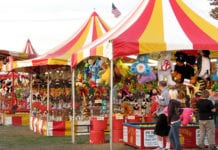Would you believe me if I told you that there are such things as memory championships here in the United States in which competitors memorize 1400 random binary digits in under thirty minutes and compete to see who can memorize a shuffled deck of 52 cards fastest?
What if I told you that these people are not savants but have brain structures and capacities on par with the average person?
What if I told you that you could learn to do the same feats of memory…and so could your children and students??
Maybe you could believe the first two, but not the last one, right? I mean, teachers struggle to get children to learn a few historical dates, and parents would love it if their child could simply remember to make their own bed!
Surely, this can’t be true…can it?
Well, it is true. As Joshua Foer explains in his wonderful TED talk, we all have the capability of remembering significant amounts more than we ever give ourselves credit for today.
SO WHERE DID OUR MEMORY GO?
The short answer is: nowhere. We still have the power to train our minds to perform incredible feats of memory.
As Joshua discovered by using tricks such as the Memory Palace, human beings can begin to make deeper and more significant connections within the brain that enable us to make memories that last.
The key is making connections and associations within the brain. Our brains are not like file cabinets or folders on a computer hard drive.
Instead, everything in the brain is connected to something else. The reason you won’t forget your child’s name (without some major physical trauma, of course) is not simply because your child is important to you. It is because you have made thousands and thousands of other connections to your child that have become interwoven together.
Picture a huge fishing net or a gigantic knot in a string, and you will begin to understand how the brain is structured.
The lesson here is this: the more connections, the more anchored the memory is. And we make more connections when we involve the senses and/or make a strong impression.
LESSONS THAT LAST
Ancient Greeks and Romans used various memory devices to remember poems, important information, and public speeches.
As Joshua Foer explains, most of these techniques now being used and adapted today at these memory championships involve spatial and visual navigation.
To illustrate his point, Foer begins his talk with a bizarre story full of memorable images. Later he explains how that story was his own memory device for recalling his speech that day.
The more the senses can become involved, the longer the lessons last and the more connections are made.
That’s why teaching with learning styles helps: not only does it make connections in each child’s “language,” but it also gives each child additional ways to embed that knowledge into their brains permanently.
As fellow TED presenter Brenda Brathwaite explains, games can be used to further involve children in learning that helps them appreciate more the significance of what occurred in the past or is occurring today, so that they remember it longer and act on that knowledge.
As she explains in her entertaining talk, her daughter came home one day having just learned about the Middle Passage, a very dark time in U.S. history. And while her daughter could recall the factual details, she could not appreciate the significance of this horrific period.
So Brenda had her daughter paint some simple wood pieces that resembled board game pieces, so that they formed families. Then they played “The Middle Passage” game, which Brenda invented. During the game, families were split apart, and some pieces died.
This wasn’t your usual game, and I encourage you to watch the video to learn more. But by the end of the game, Brenda, her husband, and her daughter were all in tears. The game had been able to communicate what the school lesson had not.
Since then, Brenda has created other games to help with understanding and better appreciating major historical events such as The Holocaust.
I am sure that her daughter and children who play these games won’t be so quick to dismiss or forget these formerly abstract facts any longer.
REMEMBER WHEN…
My son made an interesting observation the other day. He told me how he and another teacher were joking with their students about how “back in their day” they didn’t have cell phones, so they had to memorize girls’ phone numbers!
Today we don’t have to memorize numbers; we have phones. And we don’t have to memorize dates; we have Google and Wikipedia. And we don’t have to write down or remember recipes; we can bookmark them.
Is this a bad thing? No. And yes.
On the one hand, it makes our modern world possible.
On the other, we lose something about ourselves in this process, a topic wonderfully tackled in the book The Shallows: What the Internet Is Doing to Our Brains by Nicholas Carr.
And as Joshua Foer points out, we all have the capacity to remember much more if only we would challenge ourselves to get more from our memory.
His proof? The year after he covered the Memory Championship as a writer, he returned as a competitor…and won!
But his point in his talk and mine here, too, is not that with some memory tricks we can all win some competitions.
The more significant point is that these “memory tricks work because they make us work.”
This especially matters for our children. If we want them to learn, we must make our lessons memorable. We must engage their senses and make abstract facts meaningful, as Brenda did for her daughter.
When we pay attention, become deeply engaged, and experience facts beyond abstraction, we not only remember things better, but we become changed by them.
Let’s expect more of ourselves and challenge our children’s memory capacities in interesting ways. Let’s spend more time exercising our brains and our memories. Let’s create healthy brains that will remain sharper and stronger as we age.
So much of who each one of us is, is directly tied to our memories. So let’s make sure we are exercising that crucial part of all of us.








